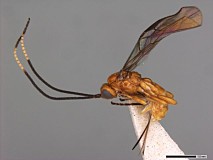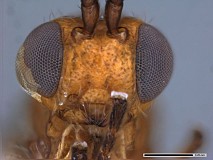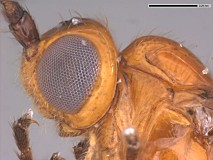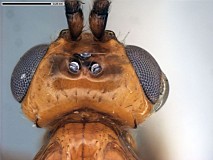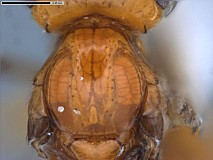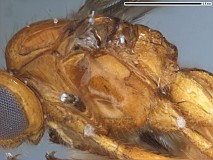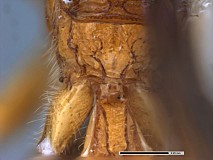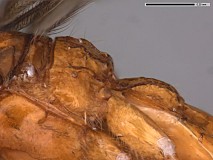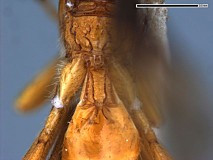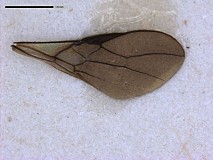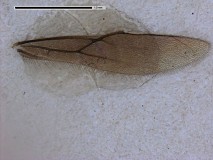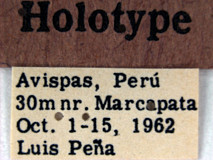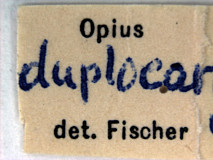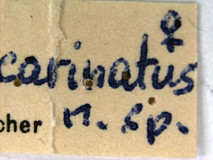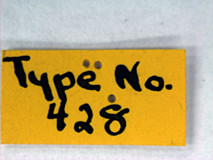Opius duplocarinatus Fischer
Opius duplocarinatus: Fischer 1965: 419 (key); Fischer, 1968: 463–464 (key); Fischer 1971: 63 (catalog).
Opius (Pendopius) duplocarinatus: Fischer 1977: 714, 721–723 (key, redescription); Fischer 1979: 484–485 (key); Yu et al. 2005, 2012 (electronic catalogs).
The antennae are shorter (with notably fewer flagellomeres) and the pronope smaller than in members of the ingenticornis species group. Further, none of the species currently included in the ingenticornis species group have either a pale, subapical ring on the antenna or an elongate ovipositor.
This species is most similar to O. marci. Both species have a pale subapical ring on the antenna (Fig. 1) whereas the flagellum is uniformly dark in all members of the ingenticornis species group. The setal pattern on the basal flagellomeres of these two species is also similar, with the setae shorter and not quite as thick as in species such as O. albericus , but thicker and darker than in species such as O. matthaei . Both O. duplocarinatus and O. marci also have a relatively long ovipositor and relatively short antenna (with 29–31 flagellomeres). Exclusion of these two species from the ingenticornis species group is based primarily on the short antennae and the T1 profiles that are concave and gradually sloping anteriorly, and secondarily on the smaller pronope (Fig. 5). Although O. duplocarinatus and O. marci are nearly identical, they have been placed in different subgenera (Fischer 1977, 1979, 1979) because O. marci has very faintly shagreened sculpture on T2 and T2 sculpture is lacking in O. duplocarinatus. There are also minor differences in the propodeum, with the areola more discrete in O. marci , and O. duplocarinatus has a distinct (though unsculptured) precoxal sulcus.
Additionally, this species shares the following characteristics with members of the ingenticornis species group: Mandible short, broadly triangular, dorsal margin strongly angled ventrally, broadly exposing labrum. Occipital carina broadly absent dorsally, the gap in dorsal view at least as wide as distance between eyes; carina well developed laterally and ventrally, widely separated from hypostomal carina ventrally. Mesoscutum without midpit; notaulus short, curved, pit-like anteriorly, narrowing and evanescent posteriorly. Propodeum with median depression at least anteriorly, never with median longitudinal carina. Mesopleuron without sternaulus; hind margin of mesopleuron not obviously crenulate on dorsal 0.5. Fore wing 2CUb arising from or near middle of first subdiscal cell. Hind wing with RS distinctly infumate; m-cu absent. T1 with dorsal carinae parallel or nearly so, extending from base to apex; laterope large, deep; dorsope absent.
There are no specimens currently determined for this OTU, or those specimens determined for this OTU are not yet mappable.
This material is based upon work supported by the National Science Foundation under Grant Number DEB 0949027 and associated REU supplement 1213790.
Any opinions, findings, and conclusions or recommendations expressed in this material are those of the author(s) and do not necessarily reflect the views of the National Science Foundation.

